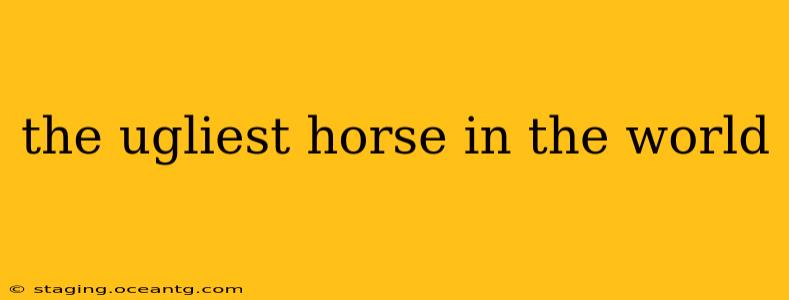The internet loves a superlative. And when it comes to animals, "ugliest" is a title that generates clicks and comments. But declaring any horse the "ugliest in the world" is a reductive and frankly, unfair assessment. Beauty is subjective, and what one person finds unattractive, another might find endearingly unique. However, some horses have distinctive features that have led to them gaining—or perhaps, earning—this somewhat dubious title. Let's explore some of the contenders and delve into why judging beauty in animals is so complex.
What Makes a Horse "Ugly"? A Matter of Perception
Before we dive into specific horses, it's crucial to acknowledge the subjective nature of beauty. What constitutes "ugly" in a horse is entirely dependent on the beholder. Some might find mismatched coloring or unusual facial features unattractive, while others might find them charmingly quirky. Breed standards play a significant role. Conformation, the way a horse is built, is highly valued in certain breeds. A horse that deviates significantly from these standards might be considered less aesthetically pleasing by those who adhere to those ideals. Ultimately, the criteria for "ugliness" are fluid and largely based on personal preference and cultural biases.
Some Horses Often Cited as Contenders
While no horse has been officially crowned "the ugliest," certain individuals have gained notoriety online. Often, these horses possess unique features that deviate significantly from the idealized image of a horse. This might include:
-
Unusual Coat Colors and Patterns: Horses with patchy or mismatched coat colors, or those with unusual markings, are sometimes viewed as less conventionally attractive.
-
Overly Prominent Features: Features such as disproportionately large or small heads, unusually shaped ears, or crooked legs can contribute to a horse's perceived "ugliness."
Is There a Scientific Basis for Judging Animal Beauty?
There's no scientific consensus on what constitutes "beauty" in animals, let alone horses. While studies exist on human perception of attractiveness in various species, these often relate to features associated with health and reproductive fitness. However, the aesthetic judgment of "ugliness" remains largely a matter of human opinion, influenced by culture, personal experience, and the biases embedded in our understanding of beauty standards.
Why We Should Celebrate Uniqueness, Not Condemn It
The pursuit of the "ugliest horse" is inherently problematic. It encourages a narrow view of beauty, perpetuating harmful stereotypes and potentially contributing to negative perceptions and treatment of animals that deviate from the norm. Horses, like all animals, deserve respect and appreciation for their individuality, regardless of their physical attributes. Each horse is unique, with its own personality and story. We should celebrate this uniqueness rather than focus on arbitrary judgments of beauty or ugliness.
Are There Any Ethical Concerns?
The very idea of labeling an animal "ugly" raises ethical questions. It trivializes the animal's intrinsic worth and potentially fosters a culture of discrimination. While many online discussions about the "ugliest horse" are lighthearted, it’s important to be mindful of the potential for such discussions to unintentionally harm or demean these animals.
Beyond the "Ugliest" Title: Appreciation for All Horses
Instead of searching for the "ugliest horse," let's focus on appreciating the diversity and beauty found in all horses. Each horse possesses unique qualities that make it special, and these differences are what enrich the equine world. Let's embrace the full spectrum of equine beauty, celebrating the unique features that make each horse an individual.
